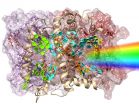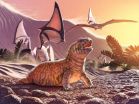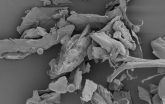(Press-News.org) Computing --the creation of supercomputers, above all-- enables scientists and engineers to analyse highly complex physical processes using simulation techniques. In this case, researchers in the UPV/EHU's Department of Computer Architecture and Technology and the Department of Materials Physics are collaborating with researchers from various universities (including the Universidade de Coimbra, Universitat de Barcelona, Lawrence Livermore National Laboratory, Martin-Luther-Universität Halle-Wittenberg, University of Liege) to analyse the photosynthesis process basing themselves on various theories because the way in which plants absorb light remains a mystery.
The molecule that carries out photosynthesis in plants is the LHC-II (Light Harvesting Complex II), comprising over 17,000 atoms. Scientists do not know how this molecule acts when it receives photons of light. Complex computers and advanced programs are needed to be able to simulate molecules as big as this one. Joseba Alberdi, a UPV/EHU computer engineer, has written up his thesis in this field, thanks to the collaboration of the ALDAPA group of the Department of Computer Architecture and Technology of the Computing Faculty, and the Nano-Bio Spectroscopy group of the Faculty of Chemistry.
The aim: to achieve high performance
The OCTOPUS software package used to make the calculations is underpinned by two theories which are the result of the reformulation of quantum mechanics and which are based on electronic density. With these two theories it has been possible to solve quantum mechanics problems using the computer; since "otherwise what you get are equations that are so complex that they are impossible to solve even with the most powerful supercomputers", explained Alberdi. "Unfortunately, very long execution times are needed to simulate systems in their actual size, and the only alternative is to use supercomputers," he added. In this work he has been able to use some of the world's fastest computers: the German Juqueen (with 458,752 processing cores), the Italian Fermi (with 163,840 cores), the German Hydra (65,320 cores) and the Catalan MareNostrum III (48,896 cores), among others.
The aim of this thesis by the researcher Joseba Alberdi was to optimize the OCTOPUS code and to achieve high performance to be able to obtain the right acceleration factors in the calculations that are made in supercomputers. In fact, to be able to execute this code across multiple processors, it was necessary to sort out various problems affecting memory and performance. Fully executing the LHC-II molecule still poses a big challenge, but they have managed to simulate significant parts of the molecule. "We have simulated systems comprising 5,759, 4,050 and 6,075 atoms; according to the data we have available, they are the biggest simulations carried out so far," said the researcher. In these simulations they have been able to prove that the theory coincides with the reality. "These simulations will enable us to understand, for the first time, the reactions that occur during the first femtoseconds (10-15 s) of photosynthesis", he explained. At the same time, the improvements incorporated into the application make it possible to simulate many other systems of this size, and as it also involves free software, all physicists can avail themselves of it.
INFORMATION:
Additional information
Joseba Alberdi (Zumarraga, Basque Country, 1986) is a computer engineer and has a Master's in Advanced Computing Systems. He wrote up his thesis entitled High-performance computing for electron dynamics in complex systems, in the ALDAPA group of the Department of Computer Architecture and Technology (Faculty of Computing) and in the Nano-Bio Spectroscopy group in the Department of Materials Physics (Faculty of Chemistry); his thesis supervisors were Javier Muguerza and Angel Rubio.
The calculations of the most important parts of the project were made using the supercomputer of the Nano-Bio Spectroscopy group and the MareNostrum III supercomputer in Barcelona.
Bibliographical references:
J. Jornet-Somoza, J. Alberdi-Rodriguez, B.F. Milne, X. Andrade, M.A.L. Marques, F. Nogueira, M.J.T. Oliveira, James J. P. Stewart and A. Rubio. "Insights into colour-tuning of chlorophyll optical response in green plants", Physical Chemistry Chemical Physics, July 2015.
X. Andrade, D. Strubbe, U. Giovannini, A.H. Larsen, M.J.T. Oliveira, J. Alberdi-Rodriguez, A. Varas, I. Theophilou, N. Helbig, M. Verstraete, L. Stella, F. Nogueira, A. Aspuru-Guzik, A. Castro, M.A.L. Marques, A. Rubio. "Real-space grids and the Octopus code as tools for the development of new simulation approaches for electronic systems", Physical Chemistry Chemical Physics, February 2015.
J. Alberdi-Rodriguez, M.J.T. Oliveira, P. García-Risueño, F. Nogueira, J. Muguerza, A. Arruabarrena, A. Rubio. "Computational Science and Its Applications--ICCSA 2014". Lecture Notes in Computer Science Volume 8582, pages 607-622, 2 July 2014.
(PHILADELPHIA) -- Alternative medicines are widely thought to be at least harmless and very often helpful for a wide range of discomforts and illnesses. However, although they're marketed as "natural," they often contain active ingredients that can react chemically and biologically with other therapies. Researchers performed a comprehensive review of all of the medications taken by senior oncology patients and found that as 26 percent were using complementary or alternative medicines (CAM), in a report published August 12th, in the Journal of Geriatric Oncology.
"Currently, ...
(Boston)--Educating clinicians on how to safely prescribe opioids can help decrease opioid misuse among chronic pain sufferers.
These findings, which appear online in the journal Pain Medicine, confirm that education can empower clinicians to make more informed clinical decisions about initiating, continuing, changing or discontinuing opioids for patients suffering from chronic pain based on a careful benefit versus risk/harm assessment.
Chronic pain affects approximately 100 million people in the U.S. making it one of the most common reasons patients seek medical ...
The great escape: why awareness of our own mortality can be bad for our health
People with low self-esteem use a variety of escape mechanisms to avoid thinking about their own mortality, new research reveals.
Researchers led by Dr Arnaud Wisman, of the University of Kent's School of Psychology, found evidence in five studies that people with low self-esteem respond to reminders of their own mortality by directing their focus away from the 'self'.
The research found an empirical and causal link between people with low self-esteem having unconscious concerns about ...
This news release is available in German. An LMU team has shown that the axons of auditory neurons in the brainstem which respond to low and high-frequency sounds differ in their morphology, and that these variations correlate with differences in the speed of signal conduction.
As a rule, the axons (i.e. signal-transmitting fibers) of the neurons in the central nervous systems of vertebrates are ensheathed in layers of myelin, which serves as a form of insulation that improves their electrical conduction properties. In fact, the fat-rich myelin coating largely consists ...
Rehabilitation is recommended for many patients following a hospital stay for acute heart disease. In a recent original article in Deutsches Ärzteblatt International (Dtsch Arztebl int 112: 527-34) Axel Schlitt et al. show that this improves prognosis for heart disease and can thus reduce patient mortality.
More than 1900 patients in Saxony-Anhalt were contacted and asked to fill out a questionnaire. They had spent time in the hospital for serious cardiovascular disease an average of 11 years earlier. The authors used the data to analyze how many of the patients who ...
Cholecystectomy and treatment for inguinal, femoral, umbilical, or abdominal hernia are common surgeries and are considered routine in Germany. In an original article in the current edition of Deutsches Ärzteblatt International (Dtsch Arztebl Int 112: 535-43), Ulrike Nimptsch and Thomas Mansky show that fewer than 0.5% of patients die as a result of such surgeries. However, in those who do die risks are frequently apparent even before surgery.
Between 2009 and 2013, 731 000 cholecystectomies and 1 023 000 herniotomies took place in Germany. Over 2400 of the patients ...
This news release is available in Spanish. The behaviour involving rejection of new foodstuffs is a typical phase in infant development, above all in 2- to 3-year-olds and which subsides around the age of 5. The children who go through dietary neophobia also display signs of anguish and anxiety and this behaviour may even turn into a habit in adulthood.
In her PhD thesis the researcher of the UPV/EHU's Faculty of Psychology Edurne Maiz conducted a study on 831 schoolchildren between the ages of 8 and 16. In the study she used questionnaires on infant neophobia -adapted ...
University of Alberta paleontologists have discovered a new species of lizard, named Gueragama sulamericana, in the municipality of Cruzeiro do Oeste in Southern Brazil in the rock outcrops of a Late Cretaceous desert, dated approximately 80 million years ago.
"The roughly 1700 species of iguanas are almost without exception restricted to the New World, primarily the Southern United States down to the tip of South America," says Michael Caldwell, biological sciences professor from the University of Alberta and one of the study's authors. Oddly however, iguanas closest ...
The humble dust collecting in the average American household harbors a teeming menagerie of bacteria and fungi, and as researchers from the University of Colorado Boulder and North Carolina State University have discovered, it may be able to predict not only the geographic region of a given home, but the gender ratio of the occupants and the presence of a pet as well.
The new findings, which were published today in the journal Proceedings of the Royal Society B, highlight the impressive amount of microbial diversity in the average household and the degree to which these ...
Dutch research shows that trained detectives of specialized observation teams are much better at registering details of a drug deal than ordinary civilians. Previous legal-psychological research revealed no relevant differences in observation skills between police professionals and civilians. The findings have been published in Legal and Criminological Psychology.
Judges and juries often assume that police officers' statements are more reliable than those of regular eyewitnesses. Because of this assumption, police officers' statements typically carry more weight in legal ...


